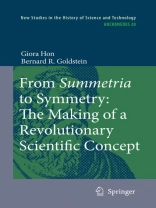Many literary critics seem to think that an hypothesis about obscure and remote questions of history can be refuted by a simple demand for the production of more evidence than in fact exists. The demand is as easy to make as it is impossible to satisfy. But the true test of an hypothesis, if it cannot be shown to con?ict with known truths, is the number of facts that it correlates and explains. Francis M. Cornford [1914] 1934, 220. It was in the autumn of 1997 that the research project leading to this publication began. One of us [GH], while a visiting fellow at the Center for Philosophy of Science (University of Pittsburgh), gave a talk entitled, “Proportions and Identity: The Aesthetic Aspect of Symmetry”. The presentation focused on a confusion s- rounding the concept of symmetry: it exhibits unity, yet it is often claimed to reveal a form of beauty, namely, harmony, which requires a variety of elements. In the audience was the co-author of this book [BRG] who responded with enthusiasm, seeking to extend the discussion of this issue to historical sources in earlier periods. A preliminary search of the literature persuaded us that the history of symmetry was rich in possibilities for new insights into the making of concepts. John Roche’s brief essay (1987), in which he sketched the broad outlines of the history of this concept, was particularly helpful, and led us to conclude that the subject was worthy of monographic treatment.
Table of Content
Tradition: Ancient Perspectives and Their Survivalinthe Early Modern Era.- The Mathematical Path.- The Aesthetic Path.- New Aesthetic Sensibilities in Italian and French Architecture.- The Ancient Concept of Symmetry in Scientific Contexts in Early Modern Times and Its Association with Harmony.- The Path to Revolution: Symmetry as a Modern Scientific Concept.- The Treatment of Symmetry in Natural History (1738–1815).- Leonhard Euler (1707–1783) and Immanuel Kant (1724–1804): “Revolutions” That Did Not Happen.- Legendre’s Revolutionary Definition of Symmetry as a Scientific Concept (1794).- New Applications of Symmetry in Mathematics and Physics: 1788–1815.
Language English ● Format PDF ● Pages 336 ● ISBN 9781402084485 ● File size 3.3 MB ● Publisher Springer Netherland ● City Dordrecht ● Country NL ● Published 2008 ● Downloadable 24 months ● Currency EUR ● ID 2148748 ● Copy protection Social DRM












